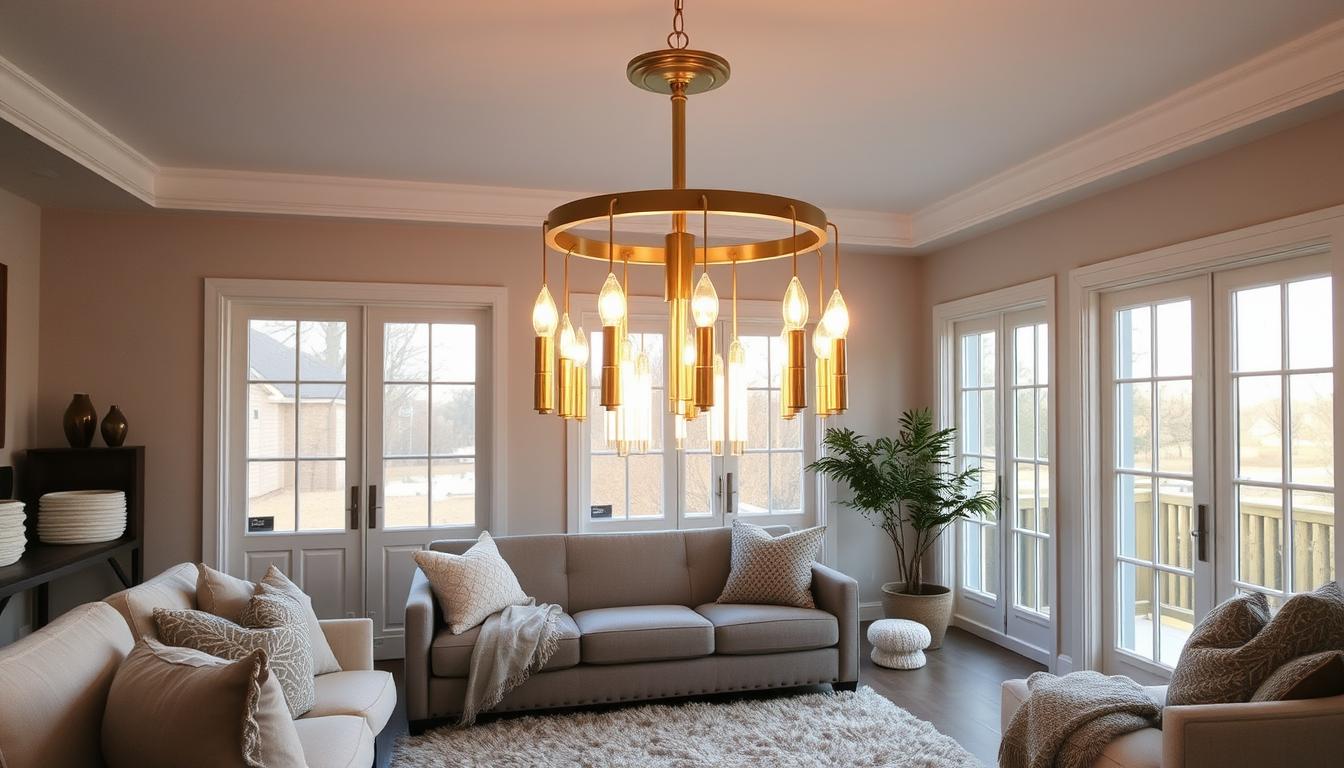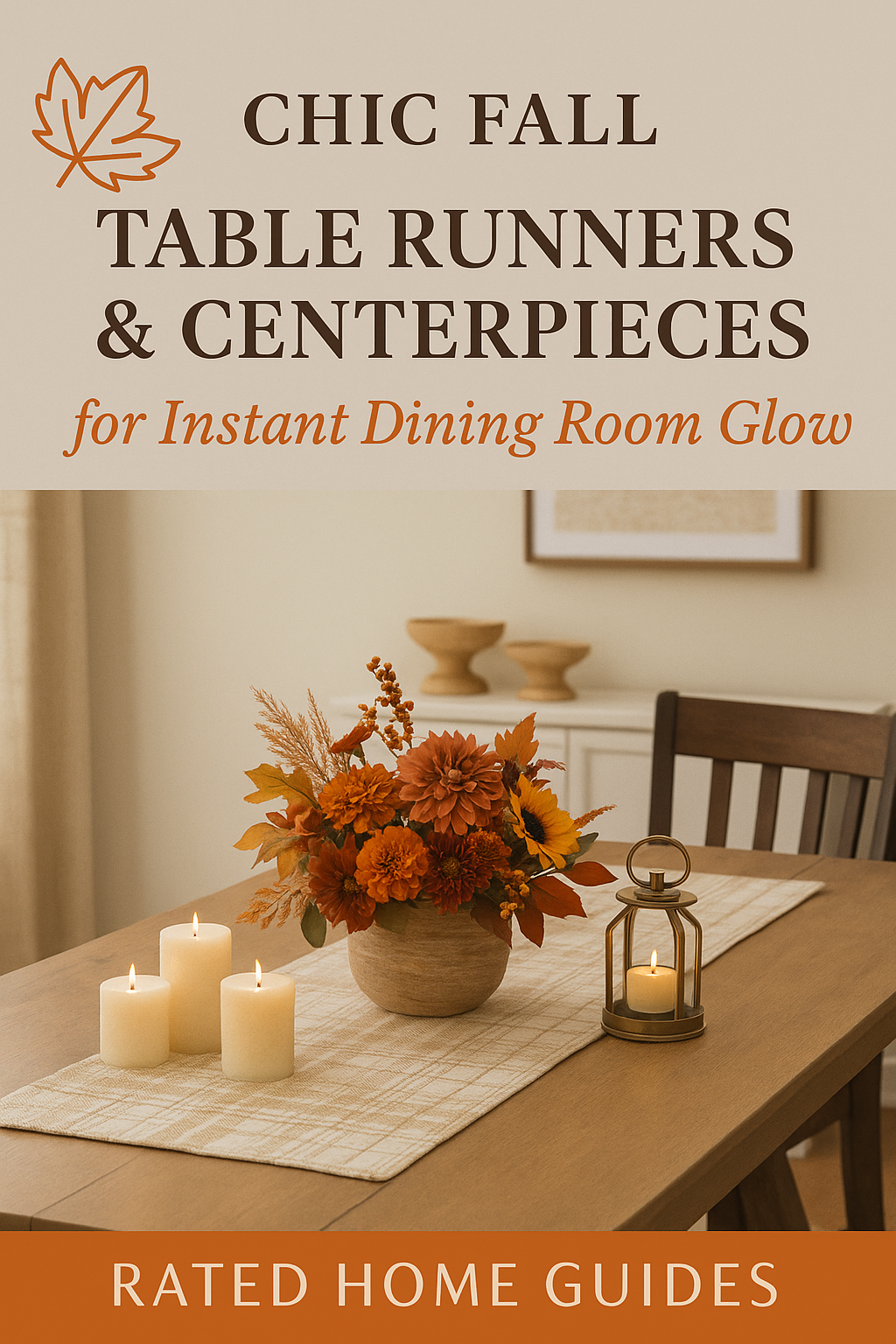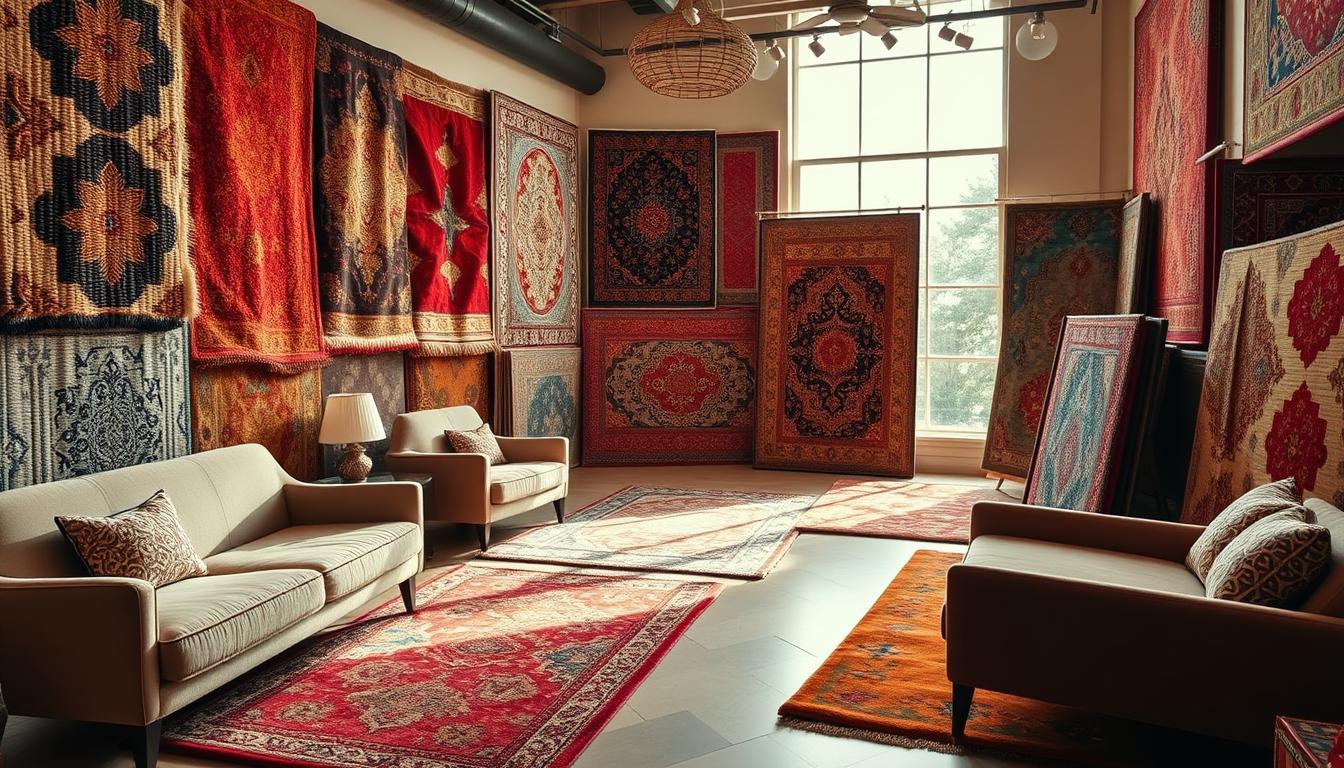Wondering how to make your house feel like home without spending a lot? Home decor keeps changing, and it’s okay to start fresh or update your space. Trends can shift, and it’s normal to follow them.
Decorating your first home or refreshing your current one can be exciting. Simple decorating tips can really help. You don’t need to be an expert to make your home look great and welcoming.
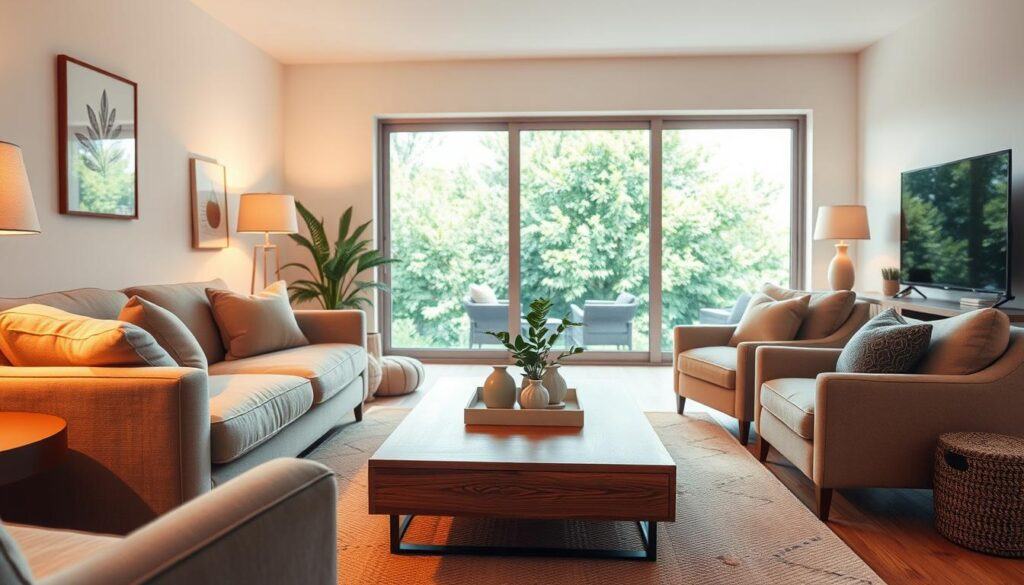
As you start decorating, remember it’s not just about the latest trends. It’s about making a space that shows who you are and what you like.
Key Takeaways
- Start with a clear plan for your space
- Invest in multi-functional furniture
- Use lighting to set the mood
- Add texture with rugs and throw blankets
- Bring in plants for a natural touch
Getting Started with Home Decoration
Starting your home decorating journey can be thrilling yet daunting, especially if you’re new. Knowing where to begin and how to make your vision come to life is crucial.
Why Home Decor Matters
Home decor is more than just making your space look nice. It’s about creating a space that shows who you are and makes you feel at ease. A well-decorated home can boost your mood and productivity, making it a great investment.
Common Challenges for Beginners
Beginners often face challenges like picking the right colors and furniture. Starting with a clear plan can help overcome these hurdles. Remember, decorating your home is a journey, and it’s okay to take it one step at a time.
For beginners, starting with simple home decoration ideas is a good approach. Begin with one room or area and focus on lighting, textiles, or wall decor.
The Emotional Impact of Your Living Space
Your living space greatly affects your emotional well-being. A well-thought-out space can be a haven of peace and comfort. Think about how you want to feel in your home and choose decor that supports that feeling.
Understanding the importance of home decor, being aware of common challenges, and considering the emotional impact of your space are key. Start your home decorating journey with these in mind. The goal is to create a space that feels like home to you.
Understanding Your Personal Decorating Style
Discovering your decorating style is a journey. It can turn your home into a reflection of you. It’s about making a space that looks good and feels like home.
Identifying What You Love
Start by looking at what you like in decor. Check out home decorating magazines, explore online platforms like Pinterest, and see the styles of places you visit. Note the colors, furniture, and textures you like. This helps you see patterns and preferences for decorating.
Popular Decorating Styles Explained
Knowing popular decorating styles helps you find what you like. Styles range from modern and minimalist to rustic and cozy. Modern style is about clean lines and function. Rustic style is warm and traditional.
How to Mix Styles Successfully
Mixing styles can make your space unique. The trick is to find a common thread, like a color or texture. For example, you can mix modern furniture with rustic accents. Try different combinations to find what feels right to you.
Creating a Style Mood Board
A mood board is a great way to see your style. It can be a physical board or a digital one on Pinterest. A mood board shows how different elements work together. It helps guide your decorating choices.
By following these steps, you can understand your decorating style. This makes it easier to use home decorating ideas easy and easy room decorating tips that show your personality.
Easy Decorating Ideas That Transform Any Space
Easy decorating ideas can make your home look new without spending a lot. You don’t need big changes to make a big difference. A few smart moves can change how your space feels.
Quick-Win Decorating Strategies
Decorating can start with quick ideas that get you excited. Here are some to begin with:
- Rearrange Your Furniture: A new layout can make a big difference. Try making a circle with your chairs.
- Add a Statement Piece: A bold art piece or a bright rug can catch the eye. It can hide less appealing spots.
- Update Your Lighting: New lamps or a stylish chandelier can change a room’s feel.
Weekend Projects with Big Impact
With a weekend, you can do big projects. Think about:
- Painting a Room: A new paint job can refresh a space. Pick a color that shows who you are.
- Creating a Gallery Wall: Use your favorite photos, prints, or art for a cool wall display.
- Upcycling Old Furniture: Old furniture can get a new life with sanding, painting, or new upholstery.
Seasonal Decorating Touches
To keep your space feeling new, add seasonal touches. It’s easy:
- Switch out throw pillows and blankets for the season.
- Add seasonal flowers or plants for color and scent.
- Change your decor to match the season’s mood. Go cozy in winter or bright in spring.
With these decorating tips, you can refresh your home. It will show off your style and change with the seasons.
Tip1: Start with a Cohesive Color Scheme
Creating a cohesive color scheme is key to a beautifully decorated home. When starting with home decorating, the many choices can be overwhelming. But, a unified color palette simplifies decisions and creates harmony.
Choosing Colors That Reflect Your Personality
The colors in your home should show your personality and style. Think about the colors you like in clothes or art. For example, if you’re calm, choose soothing blues and greens. If you’re lively, bold colors like reds and oranges might suit you better.
Also, consider your home’s natural lighting. Colors look different under different lights, so watch how they change during the day.
The 60-30-10 Color Rule
The 60-30-10 rule is a simple way to pick colors. It says 60% of your room should be one color, 30% another, and 10% an accent color. This balance keeps your space from feeling too plain or too busy.
- Dominant Color (60%): This is usually your wall color.
- Secondary Color (30%): Use this for furniture and big decor items.
- Accent Color (10%): Use it for small items like throw pillows or vases.
Color Psychology in Home Decor
Colors greatly affect our mood and a room’s feel. For instance, blue can make us feel calm, while yellow makes us happy. Knowing this can help you set the mood in your home.
Testing Colors Before Committing
Test colors before painting walls or buying colored furniture. Paint small swatches on the wall or use colored cards. Check these samples at different times and under various lights to make sure you’re happy with your choice.
By following these tips, you can create a color scheme that looks great and feels like you. Remember, the foundation of good home decorating is your color choices.
Tip2: Declutter Before Decorating
The first step to transform your living space is to remove clutter. This lets your home’s true potential shine. As a beginner, it’s tempting to add new decor. But, starting with a clean slate is crucial.
The Impact of Clutter on Your Space
Clutter makes your home feel cramped and chaotic. It’s not just about looks; it affects your mental health and focus. Decluttering brings peace and a space that shows your style.
Marie Kondo said, “A home is for comfort, not storage.” This idea is key to understanding decluttering’s importance.
Simple Decluttering Methods
Decluttering can seem hard at first. Begin by sorting items into keep, donate, sell, and discard piles. Start with one area at a time to stay focused. Remember, you likely use only 20% of your belongings 80% of the time.
- Start with small areas, like a single shelf or drawer.
- Be ruthless – if you haven’t used it in the past year, you won’t miss it.
- Keep memories, not clutter; consider photographing items you’re letting go of.
Organizing What Remains
After decluttering, organize what’s left. Choose storage that fits your style and needs. Labeling and categorizing help keep things in order. For example, using baskets or bins for miscellaneous items keeps your space tidy.
Maintaining a Clutter-Free Home
To keep your home clutter-free, establish routines like regular tidying and decluttering sessions. Adopt habits like putting things back in their place after use. This keeps your home serene and inviting.
Decluttering before decorating improves your home’s beauty and your life. As a beginner, following this tip helps create a space that feels truly like home.
Tip3: Use Textiles to Transform a Room
Textiles are a great way to change a room without spending a lot. You can easily update your decor with the seasons. Try adding throw pillows, blankets, rugs, or wall hangings to refresh your space.
Budget-Friendly Textile Options
Textiles are a smart choice for decorating on a budget. Look for deals at thrift stores, garage sales, or during sales. You can make unique throw pillows or a quilt from old sheets or fabric scraps. These budget-friendly textile options save money and add a personal touch.
Mixing Patterns and Textures
Mixing patterns and textures adds depth and interest to any room. Start with a neutral base, like a beige sofa. Then, add different patterns with throw pillows, blankets, and rugs. Mixing textures, like velvet and knit, makes your space cozy and inviting. This mixing of patterns and textures is key to a beautiful space.
Seasonal Textile Swaps
Seasonal swaps keep your decor fresh. For example, switch wool blankets to cotton throws as it gets warmer. Update your throw pillows and rugs with seasonal colors and materials. Use bright colors and light materials in spring and summer, and warm tones and heavy fabrics in fall and winter.
No-Sew Textile Projects
You don’t need to sew to decorate with textiles. There are many no-sew textile projects you can try. Use fabric glue for decorative accents or tie a scarf around a lampshade for a bohemian look. These ideas let you personalize your space without needing to sew.
Tip4: Create a Focal Point in Each Room
To add some personality to your space, think about creating a focal point in each room. A focal point is something that catches your eye and holds the room together. It’s a key part of easy home decorating ideas. You can use something natural or create one yourself, making your home look better.
Natural Focal Points vs. Created Ones
A natural focal point is something already in the room, like a fireplace or a big window. A created focal point is something you add to draw attention. This could be a bold piece of furniture, a gallery wall, or a bright color on a wall.
How to Enhance Your Focal Point
Once you’ve picked or made your focal point, you can make it pop with lighting, color, or texture. For example, spotlights can highlight art, or a vibrant rug can make a seating area stand out. The goal is to make it noticeable but not too much.
Balancing the Rest of the Room
After setting your focal point, balance the rest of the room. This means making sure other elements in the room match the focal point without fighting it. Use a consistent color scheme and spread out visual interest to achieve this balance.
Focal Point Ideas for Different Rooms
Different rooms offer unique chances for focal points. In a living room, a standout fireplace or a large art piece works well. In a bedroom, a bold headboard or striking lighting can be the focal point. Even bathrooms can have a focal point, like a unique sink or a beautiful mirror. The fun is in being creative with your easy room decorating tips.
Tip5: Master the Art of Wall Decor
Learning to decorate your walls is key to making your living space truly yours. As a beginner, it’s easy to feel lost with all the choices out there. But, with a few simple tips, you can make your space beautiful and welcoming.
Gallery Wall Basics
A gallery wall can really make a room pop. Begin by picking a theme or color scheme that ties everything together. This will help your gallery wall look cohesive and stunning.
- Choose frames that match in style and color.
- Use frames of different sizes and shapes for depth and interest.
- Plan your layout on a floor or table before you start hanging.
Alternative Wall Decor Ideas
Gallery walls aren’t for everyone. You can use wall decals or stickers for a quick and easy fix. Or, hang textiles like tapestries or scarves for color and texture.
For a rustic vibe, try reclaimed wood or wooden planks on a feature wall.
Proper Hanging Heights and Spacing
Many people forget about the height and spacing of their wall decor. Hang items at eye level, around 57-60 inches from the floor.
For spacing, leave 2-4 inches between frames. This helps your decor look balanced and neat.
Temporary Wall Decor Solutions for Renters
If you rent, you might worry about damaging walls. But, there are many temporary solutions. Use adhesive hooks or removable wall decals to hang things safely.
Another good idea is to use freestanding screens or room dividers. They add interest without any permanent changes.
Tip6: Lighting as a Decorative Element
Lighting is key in easy home decorating. It can change a room’s feel. Used right, it’s a big part of the decor.
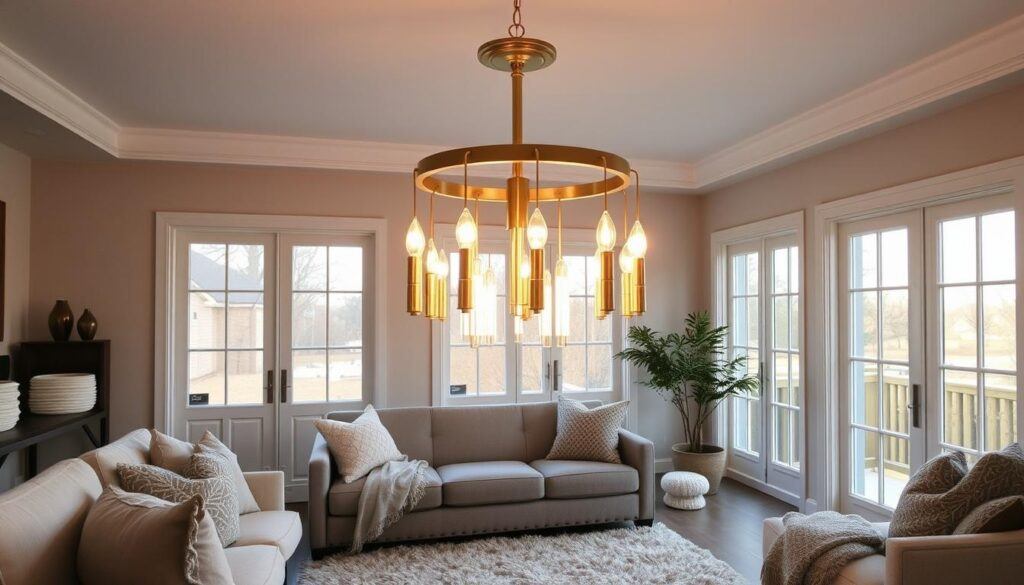
Types of Lighting Every Room Needs
Every room needs different kinds of lighting. There’s ambient lighting for overall light, task lighting for specific areas, and accent lighting for highlights.
Ambient lighting sets the room’s mood. Task lighting helps with daily tasks. Accent lighting brings out special features or decor.
Selecting Statement Light Fixtures
Choosing the right light fixtures can really make your space stand out. Think about your room’s style and size. A big chandelier can be the star of a dining room. A unique table lamp can brighten up a living room.
Using Light to Create Atmosphere
Lighting can change a room’s feel. Adjusting light brightness and warmth can create different moods. Dim, warm light can make a space cozy. Bright, cool light can energize it.
Smart Lighting Options for Beginners
Smart lighting is a good start for beginners. It lets you control lights from anywhere, change brightness, and colors. It’s convenient and can make your home look better and feel safer.
Using these lighting tips can make your home more beautiful and functional. It will be a nicer place to live.
Tip7: Incorporate Plants for Life and Color
Adding plants to your home decor is a simple way to bring life and color. If you’re new to this, don’t worry. There are many easy-to-care-for plants and creative ways to display them.
Best Low-Maintenance Plants for Beginners
Begin with hardy plants like succulents or snake plants. They’re great for busy people or those who forget to water. These plants need little care and can grow well in different light conditions.
Creative Plant Display Ideas
After picking your plants, think about how to display them. Use hanging baskets, plant stands, or macramé hangers for a decorative look. Grouping plants can make a lush, green spot in your home.
Artificial Plants: When and How to Use Them
Artificial plants have improved a lot. They’re perfect for low-light areas or for those who don’t want to care for real plants. Use them where real plants wouldn’t do well.
Troubleshooting Common Plant Problems
Even easy plants can face issues like too much water, too little water, or pests. Knowing your plants’ needs and acting fast can solve these problems.
Adding plants to your decor makes your space look better and improves air quality. As you decorate your home, remember plants are flexible and can change with your style.
Tip8: Arrange Furniture for Flow and Function
The way you arrange your furniture greatly affects your living space. A well-planned layout can make a room feel bigger, more welcoming, and comfy.
Basic Principles
To arrange furniture well, think about the room’s purpose and how people will move through it. Start by finding the room’s main focus, like a fireplace or a beautiful view. Then, arrange furniture around it.
Make sure there’s a clear path through the room. Leave enough space between furniture for easy movement.
- Place the largest piece of furniture first, such as a sofa or a bed.
- Balance the room with a mix of large and small furniture pieces.
- Consider the “traffic lane” and leave enough space for people to move around.
Common Mistakes to Avoid
One mistake is pushing all furniture against the walls. This can make a room feel cold and unwelcoming. Instead, try floating furniture away from walls to create a cozier atmosphere.
Another mistake is not thinking about the room’s functionality. For example, placing a desk in a high-traffic area can be disruptive.
Adapting Arrangements for Small Spaces
In small spaces, it’s key to choose furniture that serves more than one purpose. Use wall-mounted shelves and compact furniture to save floor space. Mirrors can also make a room seem bigger.
“The right furniture arrangement can transform a small space into a functional and beautiful area.”
Using Apps and Tools for Room Planning
If you find it hard to visualize furniture arrangements, there are apps and tools to help. These digital tools let you create a virtual room layout. This makes it easier to try out different arrangements before deciding.
By following these tips and avoiding common mistakes, you can make a space that’s both beautiful and functional. This shows easy decorating ideas that are great for decor tips for newbies.
Tip9: Add Personal Touches with Meaningful Decor
Adding personal touches can make your home unique. It’s easy for beginners to do. Displaying personal items and making DIY projects can make your space special.
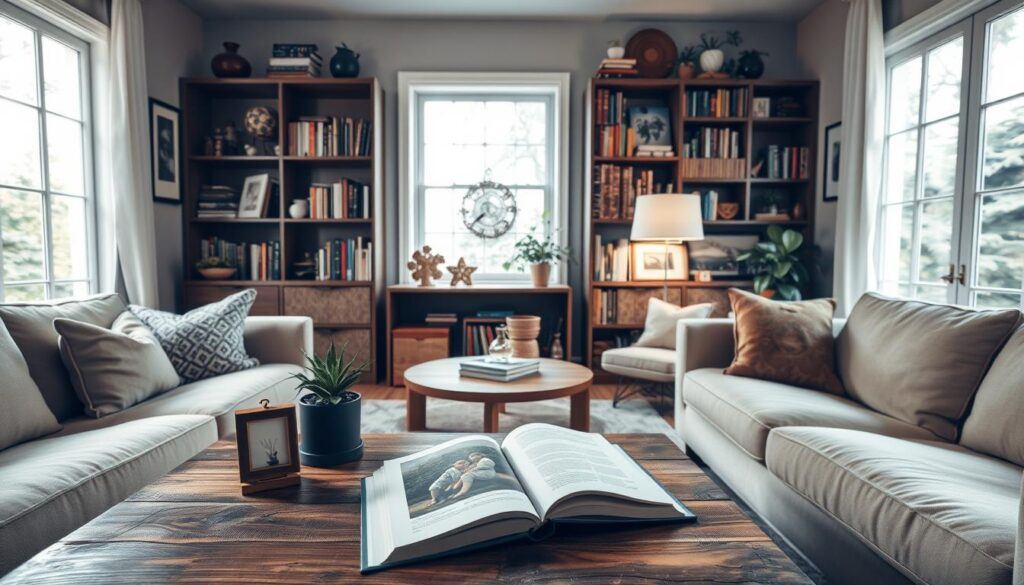
Displaying Collections and Mementos
Showing off collections and mementos adds a personal touch. It could be vintage items, family heirlooms, or travel souvenirs. Use shelves, display cases, or shadow boxes to show off your favorites.
DIY Decor Projects for Beginners
DIY decor projects are fun and budget-friendly. Beginners can try making a photo collage, a handmade wreath, or upcycling furniture. These projects add unique touches to your decor.
Balancing Personal Items with Design
It’s important to balance personal items with your design. Too many can clutter your space. Mix personal decor with neutral elements for a harmonious look.
Creating Conversation Pieces
Personal decor can start interesting conversations. Unique or meaningful items can spark discussions. Place them in areas like entryways or living rooms for maximum impact.
By following these tips, you can add character to your home. It will reflect your personality and style. Remember, the best spaces tell a story.
Tip10: Budget-Friendly Decorating Strategies
Decorating your home doesn’t have to cost a lot. There are many ways to make your space beautiful without spending too much. With a bit of creativity, you can change your living area without spending a lot.
Thrift Store and Flea Market Shopping Tips
Thrift stores and flea markets are full of unique, affordable decor. When you shop there, look for items that can be used in new ways. For example, an old ladder can become a bookshelf, or a vintage vase can be a centerpiece. Always check items for damage before buying.
Upcycling and Repurposing Ideas
Upcycling and repurposing are smart and green ways to decorate. You can make candle holders from old jars, a headboard from reclaimed wood, or a statement piece from an old door. The trick is to see the potential in things others might throw away.
Where to Splurge vs. Where to Save
Knowing where to spend and where to save is key when decorating on a budget. Spend on quality items like a comfy sofa or a solid dining table. Save on things like throw pillows or wall art that can be easily changed.
Timing Your Purchases for Maximum Savings
Timing is crucial for saving money on home decor. Watch for seasonal sales, clearance events, and holiday discounts. Also, sign up for newsletters from your favorite stores to get early sale alerts.
By using these budget-friendly decorating tips, you can make your living space beautiful and functional without spending a lot. Remember, easy home decorating tips often mean being creative and smart with what you have.
Conclusion: Building Confidence in Your Decorating Journey
Starting your home decorating journey? Remember, confidence is crucial. Use the beginner tips from this article to create a space that shows off your personality.
Decorating your home can be easy and affordable. You don’t need to be a pro. Start with a color scheme and add personal touches to make your space unique.
As you try these tips, you’ll feel more confident. You’ll enjoy making decorating choices and trying new styles. This is your chance to make your home truly yours.
Ready to start? Begin with one room or area. See how small changes can make a big difference. Your decorating adventure is just starting, and the possibilities are endless.
